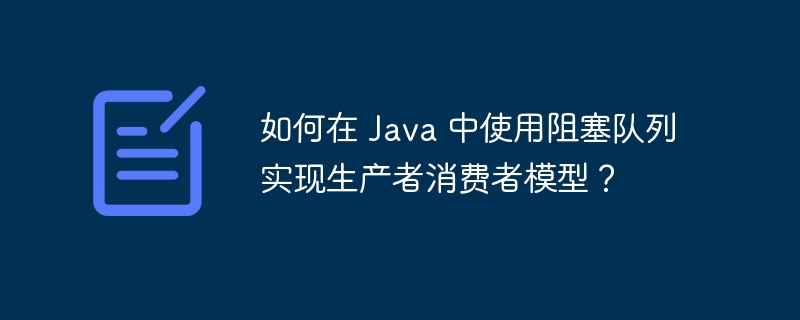
The blocking queue in Java is used to implement the producer-consumer model: producer threads add data to the queue, and consumer threads read data from the queue. When the queue is full, the producer blocks until space is available; when the queue is empty, the consumer blocks until data is available to read. Practical cases: concurrency issues such as caching systems, message queues, and pipeline processing.

Use blocking queue to implement the producer-consumer model in Java
The blocking queue is a thread-safe data structure. It helps us achieve synchronization between producers and consumers. Producer threads add data to the queue, while consumer threads read data from the queue. If the queue is full, the producer blocks until space becomes available. If the queue is empty, the consumer blocks until data is available to read.
Sample code:
Producer.java
import java.util.concurrent.BlockingQueue;
public class Producer implements Runnable {
private BlockingQueue<Integer> queue;
public Producer(BlockingQueue<Integer> queue) {
this.queue = queue;
}
@Override
public void run() {
for (int i = 0; i < 10; i++) {
try {
queue.put(i);
System.out.println("Produced: " + i);
} catch (InterruptedException e) {
e.printStackTrace();
}
}
}
}Consumer.java
import java.util.concurrent.BlockingQueue;
public class Consumer implements Runnable {
private BlockingQueue<Integer> queue;
public Consumer(BlockingQueue<Integer> queue) {
this.queue = queue;
}
@Override
public void run() {
while (true) {
try {
Integer item = queue.take();
System.out.println("Consumed: " + item);
} catch (InterruptedException e) {
e.printStackTrace();
}
}
}
}Main.java
import java.util.concurrent.ArrayBlockingQueue;
import java.util.concurrent.ExecutorService;
import java.util.concurrent.Executors;
public class Main {
public static void main(String[] args) {
BlockingQueue<Integer> queue = new ArrayBlockingQueue<>(10);
Producer producer = new Producer(queue);
Consumer consumer = new Consumer(queue);
ExecutorService executorService = Executors.newFixedThreadPool(2);
executorService.submit(producer);
executorService.submit(consumer);
executorService.shutdown();
}
}Practical case:
This model can be used to solve a variety of concurrency problems, such as:
The above is the detailed content of How to implement producer-consumer model using blocking queue in Java?. For more information, please follow other related articles on the PHP Chinese website!
 A complete list of commonly used public dns
A complete list of commonly used public dns
 python comment shortcut keys
python comment shortcut keys
 What are the differences between hibernate and mybatis
What are the differences between hibernate and mybatis
 How to use left join
How to use left join
 vcruntime140.dll cannot be found and code execution cannot continue
vcruntime140.dll cannot be found and code execution cannot continue
 How to insert page numbers in ppt
How to insert page numbers in ppt
 How to find the median of an array in php
How to find the median of an array in php
 How to solve the problem that Apple cannot download more than 200 files
How to solve the problem that Apple cannot download more than 200 files




